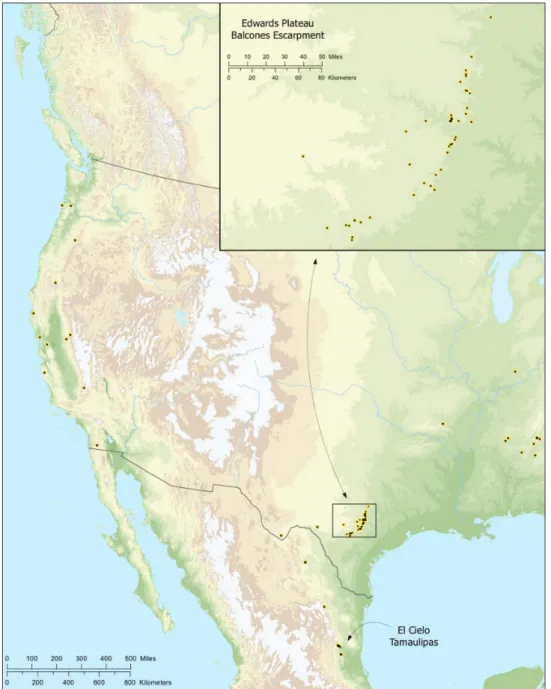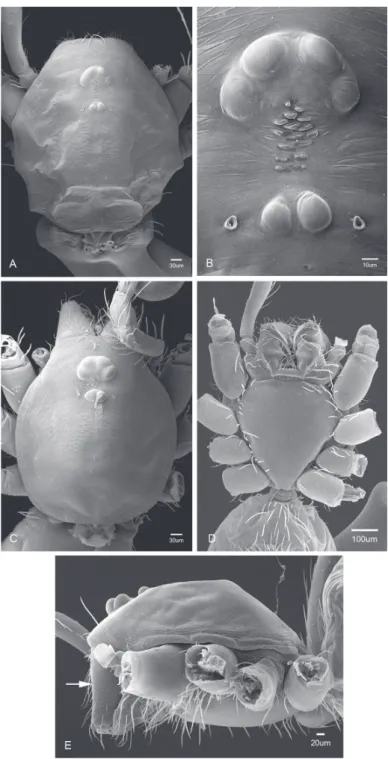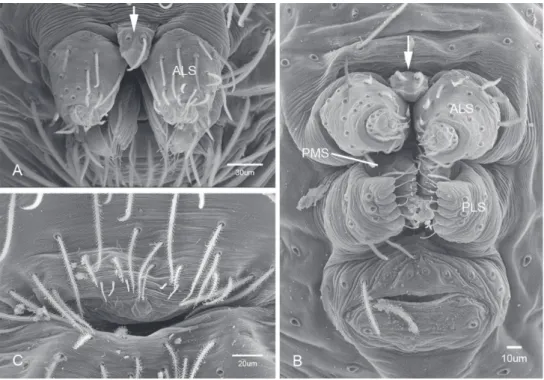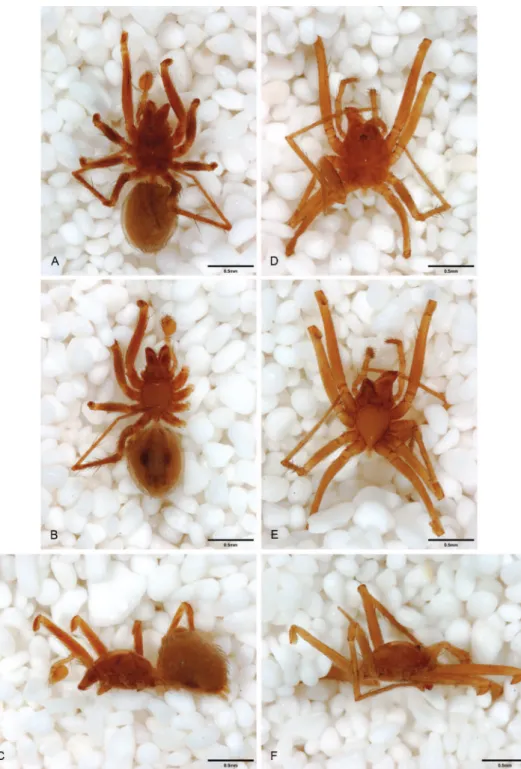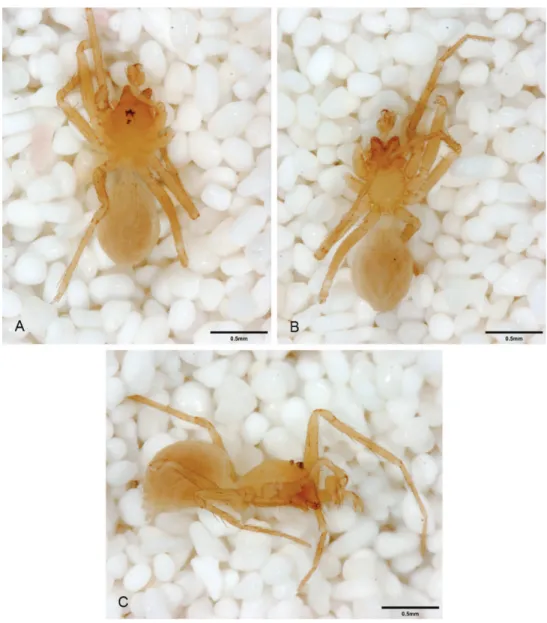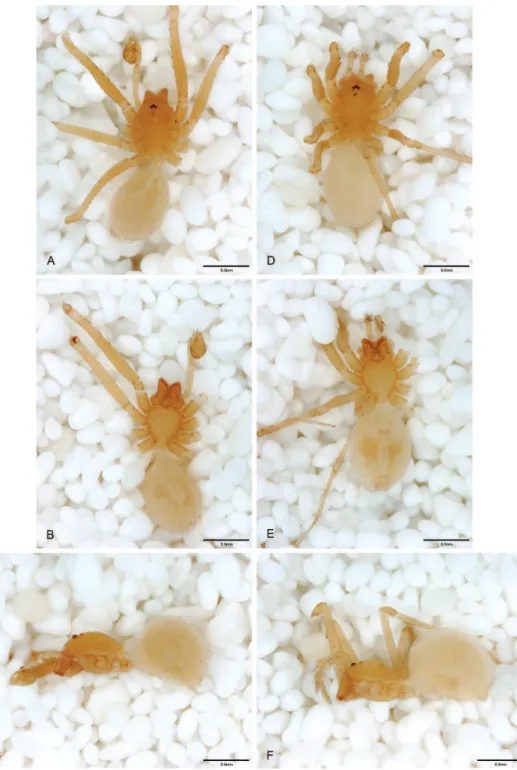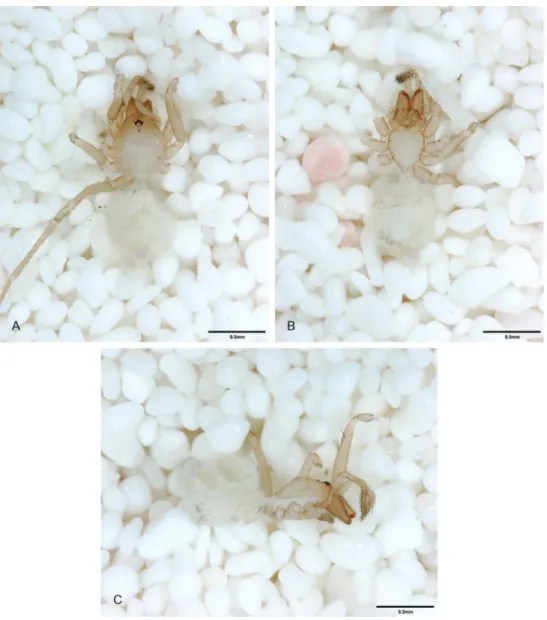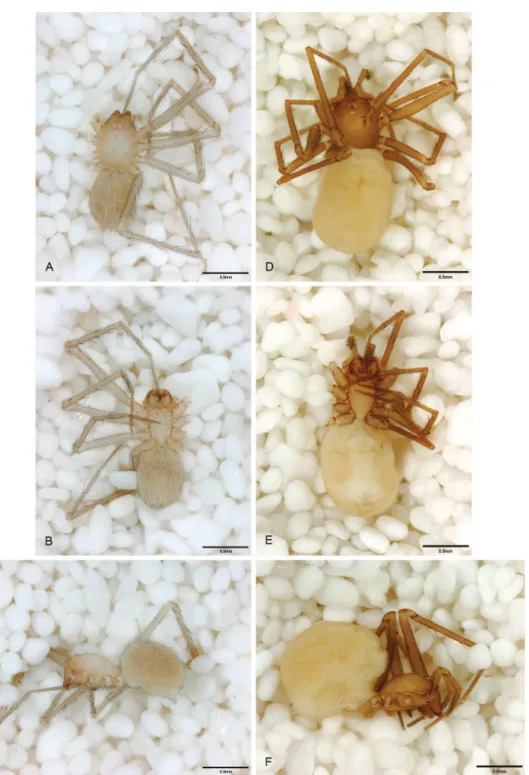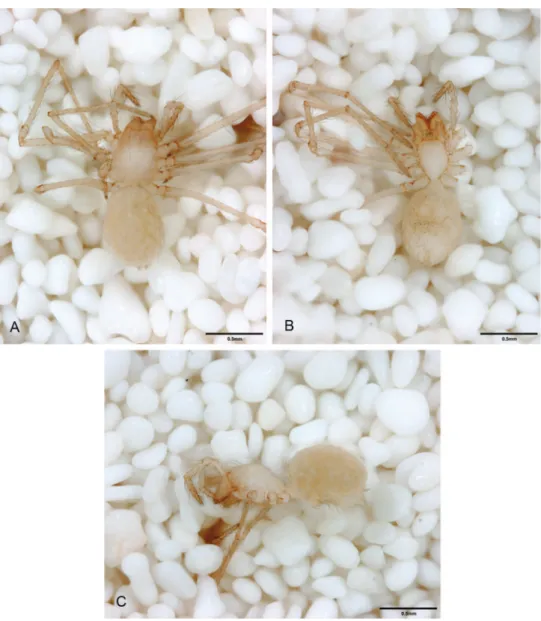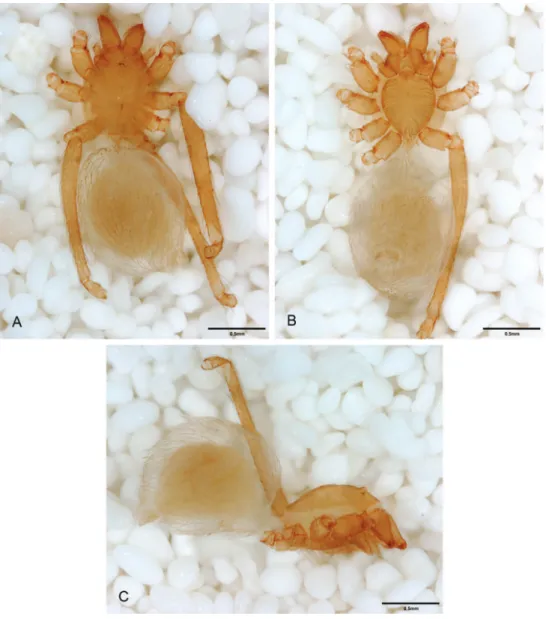Systematics, conservation and morphology of the
spider genus
Tayshaneta
(Araneae, Leptonetidae)
in Central Texas Caves
Joel Ledford1,2,†, Pierre Paquin3,‡, James Cokendolpher4,§, Josh Campbell5,|, Charles Griswold1,2,¶
1 California Academy of Sciences, Department of Entomology, San Francisco, CA 94118, USA 2 Environmen-tal Science, Policy and Management, Division of Organisms and Environment, University of California, Ber-keley, BerBer-keley, CA 94720, USA 3 SWCA Environmental Consultants, Austin, Texas, 78749, USA 4 Museum of Texas Tech University, Lubbock, Texas, 79409, USA 5 High Point University, High Point, North Carolina, 27262, USA
† urn:lsid:zoobank.org:author:F55EE588-CC9C-4348-AD0F-30F8336DEDA3 ‡ urn:lsid:zoobank.org:author:24BC95FC-15FB-4010-911A-2B3C08F93EFB § urn:lsid:zoobank.org:author:76E72B0A-A462-4D96-892C-8C30B2501978 | urn:lsid:zoobank.org:author:2EC100ED-711F-4660-BC4D-9AAFCE8F0B6F ¶ urn:lsid:zoobank.org:author:0676B242-E441-4715-BF20-1237BC953B62
Corresponding author: Joel Ledford (jledford@berkeley.edu)
Academic editor:J. Miller | Received 20 July 2011 | Accepted 3 January 2012 | Published 23 January 2012
urn:lsid:zoobank.org:pub:8EFB8D79-9061-452B-B452-4117BD2FA068
Citation: Ledford J, Paquin P, Cokendolpher J, Campbell J, Griswold C (2012) Systematics, conservation and morphology of the spider genus Tayshaneta (Araneae, Leptonetidae) in Central Texas Caves. ZooKeys 167: 1–102. doi: 10.3897/zookeys.167.1833
Abstract
he spider genus Tayshaneta is revised based on results from a three gene phylogenetic analysis (Ledford et al. 2011) and a comprehensive morphological survey using scanning electron (SEM) and compound light microscopy. he morphology and relationships within Tayshaneta are discussed and ive species-groups are supported by phylogenetic analyses: the anopica group, the coeca group, the myopica group, the microps
group and the sandersi group. Short branch lengths within Tayshaneta contrast sharply with the remaining North American genera and are viewed as evidence for a relatively recent radiation of species. Variation in troglomorphic morphology is discussed and compared to patterns found in other Texas cave invertebrates. Several species previously known as single cave endemics have wider ranges than expected, suggesting that some caves are not isolated habitats but instead form part of interconnected karst networks. Distribution maps are compared with karst faunal regions (KFR’s) in Central Texas and the implications for the
con-www.zookeys.org
Copyright Joel Ledford et al. This is an open access article distributed under the terms of the Creative Commons Attribution License 3.0 (CC-BY), which permits unrestricted use, distribution, and reproduction in any medium, provided the original author and source are credited.
servation and recovery of Tayshaneta species are discussed. Ten new species are described: T. archambaulti
sp. n., T. emeraldae sp. n., T. fawcettisp. n., T. grubbsi sp. n., T. madlasp. n., T. oconnoraesp. n., T. sandersisp. n., T. sprouseisp. n., T. vidrio sp. n. and T. whiteisp. n. he males for three species, T. anopica
(Gertsch, 1974), T. devia (Gertsch, 1974) andT. microps (Gertsch, 1974) are described for the irst time.
Tayshaneta furtiva (Gertsch, 1974) and T. uvaldea (Gertsch, 1974) are declared nomina dubia as the female holotypes are not diagnosable and eforts to locate specimens at the type localities were unsuccessful. All
Tayshaneta species are thoroughly illustrated, diagnosed and keyed. Distribution maps are also provided highlighting areas of taxonomic ambiguity in need of additional sampling.
Keywords
Spiders, Haplogynae, Leptonetidae, Neoleptoneta, Caves, Endangered Species, Troglobites, Edwards Aqui-fer, Karst Faunal Regions, Phylogenetics
Introduction
Tayshaneta are small spiders that belong to the family Leptonetidae, a group
recog-nized for its association with caves and similar cryptic habitats (Ledford et al. 2004).
Tayshaneta are widely distributed in caves of the Edward’s Plateau (Fig. 3), an
ex-tensive limestone region in Central Texas that drains into the Edward’s Aquifer and serves as the primary source of water for over 2 million people. he region is famous for its endemism and includes a high proportion of endangered and threatened spe-cies, many of which are subterranean specialists and known only from single springs or caves (Culver et al. 2003). Two Tayshaneta species are federally listed as endangered
in Central Texas, T. microps (Gertsch, 1974) and T. myopica (Gertsch, 1974) and most others are of conservation concern (Bender et al., 2005; U. S. Fish and Wildlife Service 1998, 2010). However, management and recovery eforts are limited by ex-isting taxonomy which is poorly resolved and leaves the identity and distribution of
Tayshaneta species ambiguous.
Gertsch (1974) described the majority of the North American Leptonetidae and considered twelve species as part of a closely related Texas fauna. Although he originally described these species as congeneric with European Leptoneta, several publications (Brignoli 1977, 1979; Platnick 1986) refuted this hypothesis and transferred the Texas fauna to the genus Neoleptoneta Brignoli, 1972. Two species were later added by
Co-kendolpher and Reddell (2001) and CoCo-kendolpher (2004), who also provided details on their general biology. Recent phylogenetic work has shown that Neoleptoneta is paraphyletic and three additional genera, Chisosea, Ozarkia and Tayshaneta, were de-scribed (Ledford et al. 2011). Tayshaneta presently includes eleven species restricted to
Texas caves with close relatives in the Southeast, Southern Texas and Northern Mexico (Ledford et al. 2011).
exami-nation. Furthermore, the characters used to separate species are exceptionally ine and not often visible using conventional microscopy. European specialists, includ-ing Brignoli (1972, 1974), Fage (1913) and Machado (1941, 1945) relied heavily on compound light microscopy to produce detailed illustrations which Gertsch was reluctant to use. Consequently, most species remain poorly diagnosed and positive identiication is only possible with topotypic material. Morphological homogeneity within female specimens is also problematic (Ledford 2004; Ledford and Griswold 2010) and although microscopy and preparation techniques have improved, lepto-netid taxonomy remains dependent upon the details of male genitalia. Diagnostic features for Tayshaneta in particular are subtle and often require examination using scanning electron microscopy.
Recent studies on Cicurina spiders in Texas caves (Paquin and Hedin 2004; Paquin
et al. 2008) have addressed similar problems by using molecular phylogenetic methods and ine scale geographic sampling to help resolve species limits. Although based on a single genetic locus, Paquin and Hedin (2004) clearly demonstrated that the integra-tion of molecular data is a valuable aid to overcoming the diiculties of working with cave fauna, especially when specimens are rare or present diagnostic challenges. Stud-ies of cave invertebrates are also underscored by conservation concerns, especially in Central Texas, where taxonomic identity can have profound socioeconomic impact. As emphasized by Paquin et al. (2008), the interaction between taxonomists, conservation biologists and development interests can be volatile and highlights the need for robust, integrative taxonomy based on multiple lines of evidence.
Several geological areas are recognized on the Edward’s Plateau, however most of the subterranean diversity is known from caves along the heavily faulted Balcones Escarpment (Fig. 3). he faulting serves to isolate regions of limestone and is likely correlated with the diversiication patterns of cave invertebrates (White et al. 2009). Conservation biologists have used this fragmented geology to develop a conservation strategy based on “karst faunal regions” (KFR’s), hypothesized as biologically discrete areas of cave habitat that are used to manage species recovery (U. S. Fish and Wildlife Service 1994; Veni 1992, 1994). hree KFR’s (Figs 61–62) are currently recognized in Bexar, Travis and Williamson Counties each of which includes large numbers of caves and encompasses the distributions of multiple endangered invertebrates. How-ever, KFR boundaries are limited by existing taxonomy which in most cases does not accurately relect species distributions (White and Carothers 2001).
his study revises the taxonomy of Tayshaneta based on the phylogenetic results of Ledford et al. (2011) and data collected from a morphological survey using scanning electron and compound light microscopy. Ten new species are described, along with three previously unknown sexes and all remaining species are imaged, diagnosed and keyed. he morphology and relationships within Tayshaneta are discussed and ive species-groups are identiied. Distribution maps are provided along with an evaluation of KFR’s based on revised species distributions. he primary objective of this study is to produce a functional taxonomy for Tayshaneta that will facilitate conservation and
Materials and methods
Taxon sampling
A resurgence of interest in Texas cave biology, driven largely by conservation eforts, has produced a wealth of new Tayshaneta specimens more than doubling records since Gertsch (1974). In order to prioritize collection sites, a database combining records for described species and all recent collections was developed. Collection sites were then selected to maximize sampling throughout known ranges with priority given to type localities. Outgroup selection was based on the most recent phylogenies of haplogyne spiders (Platnick et al. 1991; Ramirez 2000) and specimen availability. Be-tween 1–10 individuals were collected from each site, placed directly into 95% etha-nol and then transferred to storage at -20°C. Each specimen was assigned a unique voucher number and is accessioned in a database maintained at the California Acad-emy of Sciences (CASC).
Voucher specimens for the study are deposited at the California Academy of Sci-ences (CASC), the Texas Memorial Museum (TMM), the Museum of Texas Tech Uni-versity (TTU) and the Essig Museum, UniUni-versity of California, Berkeley (UCB).
Due to the sensitive nature of cave locations and in the spirit of respecting the rights of property owners and encouraging future research, precise locality informa-tion is not provided. Unless otherwise noted, all cave locainforma-tions are limited to within 2 kilometers. Specimens used in this study along with their voucher codes are listed in Ledford et al. (2011) and a map highlighting the study area is provided in Fig 3.
Distribution maps were produced using Arc GIS 10.0 (Environmental Systems Re-search Institute, CA). Karst faunal region boundaries were derived from shape iles pro-vided by Zara Environmental (K. O’Connor) through the U.S. Fish and Wildlife Service.
Morphology
Prior to examination with a Leo 1450VP Scanning Electron Microscope, all structures were cleaned with a ine brush or ultrasonicator and critical point dried. Best results were obtained by gradually dehydrating the specimen in increasing concentrations of ethanol for 24-48 hours prior to critical point drying. Dried specimens were then mounted on pin mount SEM stubs (Ted Pella Inc., Redding, USA) on copper-backed tape. Specimens were sputter coated for 120 seconds using a Denton Vacuum Sput-ter CoaSput-ter. Large structures were photographed using a Nikon DMX1200 camera at-tached to a Leica MZ 16 stereomicroscope. Images were then montaged using Helicon Focus v. 4.2.1 (http://www/heliconsoft.com). For male specimens, the right palp was scanned and the left was maintained with the specimen post examination using com-pound light microscopy.
and manually cleaned. Best results were obtained by removing the cuticle from the dorsal surface of the abdomen and digesting the entire structure. If the vulva re-mained unclear, it was stained for one minute with Chlorazol Black and reexamined. Images of each species were prepared using a Nikon DMX1200 camera attached to a Leica DM 4000 compound microscope. Genitalia were placed in Hoyer’s solution and examined in well slides or temporary mounts following the procedure described by Coddington (1983).
Descriptions follow the format of Ledford and Griswold (2010) and Ledford (2004). Descriptions of previously unknown sexes were based upon individuals collected at the type locality. All measurements are in millimeters and quantify the structure at its widest or longest point. A summary of anatomical abbrevia-tions used in the descripabbrevia-tions and keys is provided in Table 1. Individual images of all structures will be made available at the time of publication in Morphbank (www.morphbank.net) and species pages will be available in the Encyclopedia of Life (http://www.eol.org).
Table 1.List of Anatomical Abbreviations used in the text and igures.
Abbreviation Structure
AER Anterior Eye Row AME Anterior Median Eyes
At Atrium
E Embolus
PME Posterior Median Eyes RS Retrolateral Sclerite RTS Retrolateral Tibial Sclerite SH Spermathecal Head SS Spermathecal Stalk
TS Palpal Tarsus
VS Ventral Sclerite
Phylogeny
Akaike Information Criterion (Akaike 1973) as implemented in MrModeltest v. 2.2 (Nylander 2004). Partitioning strategies for COI and histone 3 were evaluated using Bayes Factors (Brown and Lemmon 2007) for fully partitioned, partially partitioned and unpartitioned analyses.
Bayesian analysis was performed using MrBayes v. 3.1.2 (Huelsenbeck and Ron-quist 2001) using four independent runs until the standard deviation of split frequen-cies fell below 0.01. Stationarity was evaluated by examining the stability of posterior probabilities for nodes of each MCMC run using the Cumulative and Compare plots in Are We here Yet? (http://ceb.csit.fsu.edu/awty; Nylander et al. 2008) and the irst 25% of trees were discarded from the posterior distributions of each analysis. Maxi-mum likelihood analysis was performed using 1000 bootstrap replicates in RAxML v. 7.0.4 (Stamatakis 2006) and parsimony analyses were performed in PAUP* (Swoford 2003) using 1000 iterations of a heuristic search holding 100 trees for each iteration, with random taxon addition and tree bisection-reconnection (TBR) branch-swap-ping. Branches were collapsed using the default rule in PAUP* v.4.0 b10 (collapse if Table 2. Summary tree statistics and conditions for each analysis.
Analysis Optimality Criterion,
Software Conditions Statistics
Concatenated Parsimony, PAUP* v.4b10 1000 iterations, heuristic search with TBR 130 trees, 8124 steps
COI (full partitions) Likelihood, RAxML v.7.0.4 1000 non-parametric bootstrap replicates -lnL 16062.90 Histone 3 (full partitions) -lnL 2910.70
28s rDNA -lnL 20318.74
hree-gene concatenated -lnL 34742.79 Two-gene concatenated
(COI, 28s) -lnL 34550.09
COI (full partitions) Bayesian, Mr. Bayes v.3.1.2 20,000,000 generations, burnin= 25% sdsf 0.003 COI (1st and 2nd, 3rd
positions) sdsf 0.003
COI (unpartitioned) sdsf 0.003
Histone 3 (full partitions) sdsf 0.004 Histone 3 (1st and 2nd, 3rd
positions) sdsf 0.01
Histone 3 (unpartitioned) sdsf 0.03
28s rDNA sdsf 0.008
hree-gene concatenated 50,000,000 gen, burnin=
25% sdsf 0.05 Two-gene concatenated
(COI, 28s)
20,000,000 gen, burnin=
Table 3. Primer sequences, source and annealing temperatures. Optimized annealing temperatures in bold.
Gene Forward Sequence Reference Reverse Sequence Reference Annealing
Temperature COI 1718 5-GGA GGA TTT GGA AAT TGA TTA GTT CC-3 Simon et al. (1994) 2568
5-GCT ACA ACA TAA TAA GTA TCA TG-3
Simon et
al. (1994) 44-50, 48°C
COI 1751
5 -GAG CTC CTG ATA TAG CTT TTC C-3
Simon et al. (1994) 2568
5-GCT ACA ACA TAA TAA GTA TCA TG-3
Simon et
al. (1994) 44-50, 48°C
COI PMT1 5-GGT CAA CAA ATC ATA AAG ATA TTG G-3 Folmer et al. (1994) 2568
5-GCT ACA ACA TAA TAA GTA TCA TG-3
Simon et
al. (1994) 44-50, 45°C
COI 1490-ONO 5-CW ACA AAY CAT ARR GAT ATT GG-3 Simon et al. (1994) 2568
5-GCT ACA ACA TAA TAA GTA TCA TG-3
Simon et
al. (1994) 44-50, 45°C
COI 2309 5-TTT ATG CTA TAG TTG GAA TTG G-3 Simon et al. (1994) 2776
5-GGA TAA TCA GAA TAN CGN CGA GG-3
Simon et
al. (1994) 44-50, 48°C
28srDNA ZX1 5-ACC CGC TGA ATT TAA GCA TAT-3 Mallatt and Sullivan (1998) ZR2 5-CCG AAG TTT CCC TCA GGA TAG C-3 Mallatt and Sullivan (1998)
50-60, 55°C
28srDNA 28sOCS
5-CGT GAA ACT GCT CAG AGG-3
Miller et al. (2010) 28sC
5-GGC GAA AGA CTA ATC GAA CC-3
Miller et
al. (2010) 50-60, 55°C
Histone 3 H3af
5-ATG GCT CGT ACC AAG CAG ACV GC-3
Colgan et al. (1998) H3ar
5-ATA TCC TTR GGC ATR ATR GTG AC-3
Colgan et
al. (1998) 48-55, 50°C
Histone 3 H3nf
5-ATG GCT CGT ACC AAG CAG AC-3
Colgan et al. (1998) H3nr
5-ATR TCC TTG GGC ATG ATT GTT AC-3
Colgan et
al. (1998) 48-55, 50°C
maximum length is zero). Nonparametric bootstrap support values were calculated us-ing 1000 replicate searches with random taxon addition.
results
Morphology
Exemplars for each Tayshaneta species, including undescribed species discovered dur-ing the course of this study, were photographed usdur-ing automontage, compound and scanning electron microscopy. Holotype specimens for each species were examined in order to conirm the identity of exemplars used in analyses.Images provided in this study are either taken directly from the holotype or from specimens collected at the type locality. Over 3,000 images were produced based on a set of standardized views and assembled into comparative plates. Careful attention was directed at diagnostic characters provided in Gertsch (1974) and to somatic features in order to assess varia-tion in troglomorphic morphology.
Putativesynapomorphies for Tayshaneta include a unique conformation of the fe-male genitalia, with short spermathecal stalks bearing large heads (SH, Figs 52–54) and the recurved to straight retrolateral spine on the male palpal tibia (RTS, Figs 32A– F). Body color ranges from pale brown-yellow to depigmented with faint dark patterns surrounding the eyes and ocular area. he legs are covered in ine setae and bear few scattered spines. A ventroapical preening comb on metatarsus III was observed in each species examined (Fig. 12–13 in Ledford 2004). Patellar and tibial gland morphology was similar to that described by Platnick (1986) with triangular patellar plates bearing single small pores (Figs 30–31, 33, 38, 40, 46 in Platnick 1986). he abdomen lacks distinctive patterning, is sparsely setose and pale yellow to white in color. Spinning or-gans follow the descriptions of Leptoneta infuscata Simon, 1872 (Ledford and Griswold 2010) and Calileptoneta (Ledford 2004) with the exception of bearing fewer aciniform gland spigots (6–10) on the PMS and PLS (Figs 11A–C).
In contrast to other leptonetine genera, the palpal morphology of Tayshaneta is
relatively conserved and the bulb bears few spines, specialized setae, or accessory scler-ites. he shape of the palpal tarsus is of two basic types; divided, as in T. fawcetti sp. n. (Fig. 31D) and tapering, as in T. coeca, T. microps and T. paraconcinna (Figs 31A–C). he depth of the division ranges from deeply divided as in T. fawcetti sp. n. and T. vid-rio sp. n. (Figs 31D–E) to weakly divided or swollen as in T. madla sp. n. (Fig. 31F).
An exposed tarsal organ is present dorsoapically and consists of a shallow circular base with a pair of round receptors (Figs 24G–H in Ledford et al. 2011). he embolus is weakly sclerotized, transparent and connected via a short tube to a large reservoir in the bulb (Figs 30A–D in Ledford et al. 2011). he sculpture along the margins of the embolus ranges from smooth as in T. coeca and T. myopica (Figs 36D, 44D) to bearing
tooth-like extensions and folds as in T. anopica (Fig. 33D). he embolus is typically
curved or folded around the ventroapical portion of the bulb and bears a single, circu-lar opening (Fig. 44F).
44B) and short as in T. sprousei sp. n. (VS, Fig. 48E) he VS is absent in several species, including T. coeca (Fig. 36E) and despite repeated eforts to determine whether this
structure was related to expansion no VS was observed. he retrolateral sclerite (RS) is of two types, a shallow, pocket-like invagination as in T. fawcetti sp. n. (RS, Fig. 40E–F) or a distinctly separated, oval sclerite as in T. whitei sp. n. (RS, Figs 51D–E).
he retrolateral tibial spine (RTS) is recurved to straight and ranges from short, occupying less than half the length of the palpal tarsus (RTS, Figs 31A–B, D, 32A–B, 36F), to elongate in which the spine extends greater than half the length of the palpal tarsus (RTS, Figs 31C, F, 32C, F). he RTS is situated on a shallow to pronounced base and is moveable, possibly serving as a positioning structure during mating. A ine, comb-like sculpturing extends along the entire length of the RTS in most species, but may also be smooth near the base as in T. fawcetti sp.
n. (Fig. 32D) and T. devia (Fig. 32B). Between three and four lattened setae are
located near the base of the RTS (Figs 32A–F) along with several unmodiied setae surrounding the base.
Examination of female genitalia using compound microscopy revealed relatively little variation among species and in most cases female specimens appear nearly iden-tical in structural details (Figs 52–54). he preparation of female genitalia was prob-lematic as the weakly sclerotized spermathecal stalks do not remain in a ixed position and slight diferences in orientation can dramatically alter the structure’s appearance. Even with careful preparation techniques the vulva is diicult to precisely position for comparison among individuals. he atrium is suboval to triangular and covered in ine pores. he spermathecal stalks are twisted and connect to the atrium basally via short sclerotized tubes. he spermathecal heads are swollen, circular (Figs 52A, C–F, 53A–B, D–F, 54A–C, E) to elongate (Figs 53C, 54D) and covered in ine pores.
Phylogeny
Results of phylogenetic analyses follow Ledford et al. (2011) and summary statistics for each analysis are presented in Table 2. Phylograms for concatenated analyses (Bayes-ian, maximum likelihood, parsimony) are presented in Figures 4-6 and independent gene trees are in Figures 7-9. Nodes with a posterior probability of 95% and greater are considered supported and all remaining nodes are collapsed. Nodes for maximum likelihood and parsimony analyses with bootstrap support values of 75% and greater are considered supported and all remaining nodes are collapsed.
Tree topologies are identical to Ledford et al. (2011) and few instances of conlict between analyses are observed. Tayshaneta monophyly is corroborated by all analyses
although its relationship to other North American leptonetid genera is ambiguous (Figs 4-9). Eight described species are represented in the analyses, including T. anopica
(Gertsch, 1974), T. bullis (Cokendolpher, 2004), T. coeca (Chamberlin & Ivie, 1942),
T. concinna (Gertsch, 1974), T. devia (Gertsch, 1974), T. microps (Gertsch, 1974), T.
undescribed species are also represented, T. fawcetti sp. n. (Figs 19, 40), T. madla sp. n. (Figs 21, 42), T. oconnorae sp. n. (Figs 24, 45), T. sandersi sp. n. (Figs 26, 47) and T.
whitei sp. n. (Figs 30, 51), each of which has diagnostic morphology.
Four clades recovered by analyses are identiied as species-groups in the discussion: 1) the anopica group, consisting of T. anopica + T. concinna (Node A), 2) the myopica
group, consisting of T. myopica + T. paraconcinna (Node B), 3) the microps group, consisting of T. microps + T. madla (Node C) and 4) the sandersi group, consisting of
T. sandersi sp. n. + T. whitei sp. n. (Node D). Although conlict among trees is limited,
the resolution among three species (T. bullis, T. coeca, T. devia) in concatenated analysis difers with results from independent analysis of COI and 28s rDNA. In both gene trees, T. devia is supported (Node E, Fig. 7) and in the COI tree a sister group relation-ship is recovered with T. coeca (Node F, Fig. 7). Furthermore, the COI tree supports T.
bullis as sister to the microps species-group (Node G, Fig. 7). However, T. devia is not
supported by concatenated analyses and relationships among T. coeca and T. bullis are unresolved.
Discussion
Among the most interesting results of the phylogenetic analyses is the contrast in branch lengths between Tayshaneta and the remaining North American genera (Figs 4-6). Although sampling and rate variation among genes (Figs 7-9)are known to af-fect branch lengths, the close relationships, morphological similarity and narrow geo-graphic distributions of Tayshaneta suggest that it is a relatively recent radiation of species. Similar radiations are known for Cicurina spiders (Paquin and Dupérré 2009; Paquin and Hedin 2004) and Texella harvestmen (Ubick and Briggs 1992, 2004) both of which show similar biogeographic patterns and ainity for caves. Recent work has shown that the diversiication patterns of Cicurina is correlated with the complex
fault-ing in the region (White et al. 2009) and may serve as a general model to explain the diversity of the Texas cave fauna. On-going work has been directed at synthesizing the distributions for multiple cave invertebrates in order to develop a comprehensive understanding of the Texas fauna (Reddell et al. in prep.).
Although most Tayshaneta species have relatively conserved genitalic morphology,
intraspeciic variation in somatic features related to cave life (troglomorphism) is ex-treme and often includes a range of eye and pigment reduction. In T. myopica, for example, multiple morphotypes are often found within a narrow geographic distribu-tion and range from darkly pigmented, large-eyed individuals (Figs 55E–F) to lightly pigmented, reduced-eyed forms (Fig. 55A–C), to complete eye and pigment loss (Fig. 55D). While these diferences likely indicate varying degrees of local adaptation to caves, the intergradient morphologies observed suggest that some species may have an adaptive cline from surface to cave-adapted morphotypes. Similar patterns of troglo-morphic variation have been reported in Texella harvestmen that show multiple
1992, 2004). In T. reddelli and T. reyesi for example, species limits are often indistinct as specimens show a gradual reduction in eyes, pigment and tubercles on the carapace. One intriguing hypothesis is that populations are actively colonizing caves and becom-ing increasbecom-ingly more troglomorphic, similar to the adaptive shift model proposed for Hawaiian isopods (Rivera et al. 2002).
Biogeographic relationships within Tayshaneta relect the fragmented geology of re-gion as distributions are allopatric and few cases of sympatry are known. However, dis-tributions for most species remain poorly characterized and relect incomplete sampling, especially of surface localities, which are rarely inventoried as part of cave surveys. Species distributions in Bexar and Travis Counties are particularly complex and several undeter-mined records (Fig. 61) likely represent range extensions or additional species, the iden-tiication of which will help resolve areas of taxonomic ambiguity. he most signiicant area of biogeographic ambiguity are caves and surface habitats in Comal and Hays Coun-ties both of which remain poorly inventoried and are essential to resolving species limits, especially between T. coeca (Chamberlin & Ivie, 1942) and T. devia (Gertsch, 1974).
he majority of species described by Gertsch (1974) were known from single lo-calities and was used as the primary justiication for the endangered status of T. microps
(Gertsch, 1974) and T. myopica (Gertsch, 1974) (U. S. Fish and Wildlife Service 1994,
2000). Recent sampling eforts, combined with the molecular and morphological data presented in this study, have shown that most species are more broadly distributed than expected but still of limited distribution. Furthermore, molecular data suggest that most troglobitic species are actively using subterranean microissures and voids as corridors for dispersal between caves. he most striking examples are for the species
T. anopica (Gertsch, 1974), T. myopica (Gertsch, 1974) and T. sandersi sp. n. each of
which have populations in diferent caves that share identical haplotypes for the loci surveyed in this study. While these connections are not surprising given the geology of the area, they set a precedent for interpreting the distribution of other Tayshaneta
spe-cies and are likely to efect conservation and management decisions.
Karst faunal regions
While the distribution of Tayshaneta is broader than anticipated, it is nevertheless highly restricted, especially when compared to other endangered invertebrate groups.
Cicurina and Texella, for example, have highly active hunting lifestyles and are known
to occur in far more caves. In contrast, Tayshaneta are more sedentary, spending most of their lives in webs with the exception of males that may leave the web upon matu-rity. Not surprisingly, the distribution of most Tayshaneta species closely corresponds to established KFR’s. In Bexar County, T. microps is restricted to the Government
Can-yon KFR (Fig. 63) and despite extensive sampling no additional populations have been discovered. T. madla sp. n. and T. whitei sp. n., however, occur in multiple KFR’s and although are not currently listed as endangered show that KFR’s are not biologically exclusive as presently deined. T. myopica (Fig. 62) shows a similar pattern in Travis County, where most populations are known from the Jollyville KFR as well as in the McNeil/ Round Rock KFR.
Following the arguments of White and Carothers (2001), the presentation of these data is not designed to be a critique of the KFR strategy but rather highlights that the geological complexity and phylogenetic histories of invertebrates in the region make the delineation of boundaries a daunting task. From a conservation perspective, the use of KFR’s have been successful at acquiring new cave habitat and establishing karst preserves, both of which are essential to the long-term protection of the karst inver-tebrate fauna. As recovery plans, local initiatives and monitoring continue to develop in the region taxonomic studies that integrate all available data will be essential to the successful implementation of the KFR conservation strategy.
Taxonomy
Key to species of Tayshaneta
he key presented here relies heavily on ine details of the male and female genitalia, some features of which are not visible using conventional light microscopy or without special preparation techniques. Scanning electron and compound light microscopy is essential for positive identiication and the females of most species are not diagnosable in the absence of associated males.
1 Male palpal tarsus tapering apically, rarely with weak division (Figs 31A–C); ventral sclerite present or absent; embolus rounded to rectangular; retrolateral sclerite not pocket-like or absent; females with round spermathecal heads (Figs 52A–F, 53A, D–F, 54A–C, E) ...2
Note. he division of the palpal tarsus in some species is very weak and often
appears entire except under high magniication (Fig. 31F).
2 Bulb bearing a prominent ventral sclerite (VS, Figs 33, 37, 44-48); embolus rounded to sculptured along margin, with or without a large basal tooth or fold (Figs 33, 37, 45, 47) ...3
– Bulb lacking a ventral sclerite (Figs 34–36, 38, 42–43, 51); embolus rounded to distinctly sculptured along margin, with or without a small basal tooth (Figs 42–43, 51) ...9
3 Ventral sclerite elongate (VS, Figs 44E, 46E) to greatly reduced (VS, Fig. 48E); embolus rounded and spoon-shaped (E, Figs 44D, 46D) to suboval (E, Fig. 48D), lacking sculpture along margin ...4
– Ventral sclerite elongate; embolus shape irregular, with sculpture, bifurcation, or large basal tooth along margin (E, Figs 33D, 37D, 45D, 47D) ...6
4 Ventral sclerite short, occupying less than the width of the embolus (VS, Figs 48B, D–F); retrolateral tibial spine elongate, straight to slightly curved, at least 0.50×tarsus length; embolus suboval, lush with apical portion of bulb (E, Fig. 48D–F) ...T. sprousei sp. n.
Dist. Known from two caves on Camp Bullis, Bexar County, Texas (Fig. 59).
Note. Females for this species are unknown.
– Ventral sclerite elongate, occupying at least 0.50× length of apical portion of bulb (VS, Figs 44E, 46E); retrolateral tibial spine recurved, short, occupying much less than 0.50× length palpal tarsus (RTS, Figs 32A, 44A, 46A); embo-lus spoon shaped, apically extended beyond bulb (E, Figs 44E, 46E) ...5
5 Base of embolus sharply curved, projecting ventrally (Fig. 44D), smooth along its margin; embolus folded over apical portion of bulb (E, Fig. 44E); retrolateral tibial spine weakly recurved, on elevated base (RTS, Fig. 44A); eyes and pigmentation variable, but usually greatly reduced (Figs 23A–F); large, thin spiders, length femur I 1.5–2.0× carapace length... ...T. myopica (Gertsch, 1974)
Dist. Caves of Travis and Williamson counties, Texas (Fig. 57).
Notes. T. myopica and T. paraconcinna are diicult to separate and require
close inspection of subtle genitalic characters, preferably using scanning elec-tron microscopy. In several cases, particularly in Williamson County, these species are only reliably diagnosed using a combination of genitalic morphol-ogy and molecular data.
– Base of embolus weakly curved, projecting anteriorly, often with an apical cleft (E, Fig. 46D); retrolateral tibial spine sharply recurved, pick-like, on short base (RTS, Fig. 46A); eyes and pigmentation variable, but usually dark-ly pigmented with well-developed eyes (Figs 25A–F); short, robust spiders, length femur I 1.2–1.5× carapace length ... ...T. paraconcinna (Cokendolpher & Reddell, 2001)
Dist. Broadly distributed in caves and surface habitats from Bell County
South through Williamson, Travis and Blanco Counties (Fig 57).
Figure 1. Images of habitat and cave entrances for Tayshaneta species. A Cobb’s Ranch, near Cobb’s Caverns, Williamson County, Texas, type locality for T. anopica (Gertsch, 1974) showing karstic terrain
B Entrance to Government Canyon Bat Cave, Bexar County, Texas, type locality for T. microps (Gertsch, 1974) C General habitat of T. sandersi sp. n., District Park Cave, Travis County, Texas, (M. Sanders)
spine short to elongate; embolus narrowly or broadly bifurcate, with or with-out large basal tooth ...7
– Pigmented, large-eyed spiders with dark patterns surrounding the ocular area; length femur I 1.0–1.5× carapace length; retrolateral tibial spine short, occu-pying less than 0.5× length of palpal tarsus; embolus broad, with prominent basal tooth ...T. concinna (Gertsch, 1974)
Dist. Caves and surface habitats in Travis County, Texas (Fig. 56).
7 Embolus bifurcate, with sharp lobes (E, Figs 33D, 47D); ventral sclerite posi-tioned retrolaterally, base indistinct; retrolateral tibial spine short to elongate ....8
– Embolus bifurcate, with rounded lobes (E, Fig. 45D); ventral sclerite posi-tioned mesally, on distinct base (VS, Fig. 45E); retrolateral tibial spine short, occupying less than 0.5× length tarsus ...T. oconnorae sp. n.
Dist. Known from two caves in Southern Hays County, Texas (Fig. 58).
8 Embolus broad, with distinct basal tooth (E, Fig. 33D); ventral sclerite straight; retrolateral tibial spine elongate, occupying at least 0.50× length of palpal tarsus ...T. anopica (Gertsch, 1974)
Dist. Known from two caves in Northern Williamson County, Texas
(Fig. 56).
– Embolus narrow, bifurcate (E, Fig. 47D); ventral sclerite prolaterally curved (VS, Fig. 47E); retrolateral tibial spine short, occupying less than 0.5× length of palpal tarsus ...T. sandersi sp. n.
Dist. Known from three caves in the Onion Creek watershed of Barton Springs, Travis County, Texas (Fig. 56).
9 Embolus rounded to rectangular, lacking basal tooth and with minimal sculpture along margins (E, Figs 34–36, 38); retrolateral tibial spine short to elongate, recurved or straight ...10
– Embolus rounded to rectangular, with prominent basal tooth (E, Figs 42, 43, 51); retrolateral tibial spine elongate, occupying at least 0.50× length of the palpal tarsus ...13
10 Embolus oval or tapering apically (E, Figs 34D, 38D), lush or extended beyond apical portion of bulb (Figs 34B, 38B); retrolateral tibial spine short, occupying less than 0.50× length of palpal tarsus ...11
– Embolus rectangular to gently curved along its base, lush with apical portion of bulb; retrolateral tibial spine short to elongate ...12
11 Eyes reduced, lacking pigmentation near ocular area (Figs 13A–F); femur I 1.35–1.75× carapace length; embolus rectangular to oval, not tapering api-cally (E, Fig. 34D), retrolateral tibial spine sculptured along its entire length (RTS, Fig. 34A) ...T. archambaulti sp. n.
Dist. Known from two caves in Southern Hays County, Texas (Fig. 58).
– Eyes large and darkly pigmented near ocular area (Figs 17A–E); femur I 1.0–1.3× carapace length; embolus tapering apically, extending beyond apical portion of bulb (E, Fig. 38D); retrolateral tibial spine stout, distinctly lacking sculpture along its base (RTS, Figs 31B, 32B) ...T. devia (Gertsch, 1974)
Dist. Known from caves and surface habitats in Southern Williamson through
Travis Counties, Texas (Fig. 56).
12 Embolus rectangular, folded apically (E, Figs 35D–F); retrolateral tibial spine elongate, occupying at least 0.50× length of the palpal tarsus (RTS, Fig. 35A) ...T. bullis (Cokendolpher, 2004)
Dist. Known from two caves on Camp Bullis, Bexar County, Texas (Fig. 59).
– Embolus rectangular and gently curved along its base (E, Fig. 36D); retrolat-eral tibial spine short, occupying less than 0.50× length of palpal tarsus (RTS, Fig. 36F) ...T. coeca (Chamberlin & Ivie, 1942)
Dist. Known from caves and surface habitats in Hays through Comal
Coun-ties, Texas (Fig. 58).
13 Eyes and pigmentation variable, greatly reduced in one species (Figs 22A–F, 30A–F); palpal tarsus tapering apically (Figs 31A–C); femur I 1.3–1.9× cara-pace length; embolus with small basal tooth, rounded to quadrate apically (E, Figs 43D, 51E) ...14
– Eyes large and darkly pigmented near ocular area (Figs 21A–C); palpal tarsus weakly divided apically (TS, Fig. 31F); femur I 1.3–1.7× carapace length; em-bolus with large basal tooth, rounded at apex (E, Fig. 42D) ...T. madla sp. n.
Figure 4. hree gene concatenated Bayesian phylogeny from Ledford et al. (2011). Highlighted and enlarged area indicates Tayshaneta. Black nodes correspond to a posterior probability >95%. Tayshaneta
highlighted in green and enlarged at right. Aanopica species-group Bmyopica species-group Cmicrops
Figure 5. hree gene concatenated maximum likelihood phylogeny from Ledford et al. (2011). High-lighted and enlarged area indicates Tayshaneta. Black nodes correspond to bootstrap support >75%. Tay-shaneta highlighted in green and enlarged at right. Aanopica species-group B myopica species-group
Figure 7. Bayesian gene tree, cytochrome oxidase I (COI) from Ledford et al. (2011). Highlighted and enlarged area indicates Tayshaneta. Black nodes correspond to a posterior probability >95%. Tayshaneta
highlighted in green and enlarged at right. Aanopica species-group Bmyopica species-group Cmicrops
Figure 8. Bayesian gene tree, histone 3 (H3) from Ledford et al. (2011). Highlighted and enlarged area indicates Tayshaneta. Black nodes correspond to a posterior probability >95%. Tayshaneta highlighted in green and enlarged at right. Aanopica species-group Bmyopica species-group Cmicrops species-group
Figure 9. Bayesian gene tree, 28s rDNA (28s) from Ledford et al. (2011). Highlighted and enlarged area indicates Tayshaneta. Black nodes correspond to a posterior probability >95%, gray nodes to 75-94%.
Tayshaneta highlighted in green and enlarged at right. Aanopica species-group Bmyopica species-group
14 Eyes and pigment greatly reduced, only faint eyespots present (Figs 10A–B, 22A–F); retrolateral sclerite absent; embolus distinctly rounded at apex (E, Fig. 43D) ...T. microps (Gertsch, 1974)
Dist. Known only from Government Canyon Bat Cave, Bexar County, Texas
(Fig. 58).
– Eyes and pigment normal, with dark marking surrounding ocular area (Figs 30A–F); retrolateral sclerite present, distinctly separated from bulb (RS, Figs 51D–E); embolus quadrate, curved apically (E, Fig. 51D) ....T. whitei sp. n.
Dist. Known from caves in Bexar and Medina Counties, Texas (Fig. 59).
15 Embolus with distinctive basal tooth, shape rectangular to bifurcate (E, Figs 40F, 49D) ...16
– Embolus smooth along margins, shape oval to subquadrate, with weakly de-veloped basal swelling or absent (E, Figs 39D, 41D, 50D) ...17
16 Eyes and pigment greatly reduced (Figs 19A–F), femur I 1.60-1.83× carapace length; embolus rectangular, with distinctive basal tooth (E, Fig. 40F); retro-lateral tibial spine short, smooth at base (RTS, Figs 40A, D); female genitalia with elongate spermathecal heads (SH, Fig. 53C) ...T. fawcetti sp. n.
Dist. Known only from Fawcett’s Cave in the Devil’s River State Natural
Area, Val Verde County, Texas (Fig. 60).
Figure 11.Spinneret morphology for male Tayshaneta species. AT. myopica (Gertsch, 1974) male, Ped-ernales River, arrow to colulus BT. devia (Gertsch, 1974), MacDonald Cave, spinning ield CT. devia
– Eyes and pigment variable (Figs 28A–F), femur I 1.40–1.50× carapace length; embolus with large basal tooth and distinctive fold (E, Fig. 49D); retrolat-eral tibial spine elongate, sculptured along its length (RTS, Fig. 49A); female genitalia with circular spermathecal heads (SH, Fig. 54C) ... ...T. valverdae (Gertsch, 1974)
Dist. Known from caves and surface habitats in Bandera, Uvalde and Val
Verde Counties, Texas (Fig. 60).
17 Embolus oval, with or without apical fold (E, Figs 41D, 50D); ventral sclerite reduced or bifurcate apically (VS, Figs 41E, 50D–F); females with elongate spermathecal heads (SH, Fig. 54D) ...18
– Embolus rectangular, tapering apically, with weak basal swelling (E, Fig. 39D); ventral sclerite stout (VS, Fig. 39E); females with large, circular spermathecal heads (SH, Fig. 53B) ...T. emeraldae sp. n.
Dist. Known only from Emerald Sink, in Western Val Verde County,
Texas (Fig. 60).
18 Eyes and pigment reduced (Figs 29A–C), femur I 1.57–1.84× carapace length; ventral sclerite with distinctive division apically (VS, Figs 50D–F); embolus elongate, oval and without apical fold (E, Fig. 50D); female genitalia with elongate spermathecal heads (SH, Fig. 54D) ...T. vidrio sp. n.
Dist. Known only from 400ft. Cave, Brewster County, Texas (Fig. 60).
– Eyes and pigment normal (Figs 20A–C), femur I 1.8× carapace length; ven-tral sclerite reduced (VS, Fig. 41E); embolus oval with distinctive apical fold (E, Fig. 41D) ...T. grubbsi sp. n.
Dist. Known only from Litterbarrel Cave, Val Verde County, Texas
(Fig. 60).
Tayshaneta Ledford & Griswold, in Ledford et al. 2011 http://species-id.net/wiki/Tayshaneta
Leptoneta Simon 1872 (in part); Chamberlin and Ivie 1942 (in part); Gertsch 1974
(in part).
Neoleptoneta Brignoli 1972 (in part); Brignoli 1977 (in part); Platnick 1986 (in part);
Cokendolpher and Reddell 2001 (in part); Cokendolpher 2004 (in part); Ledford et al. 2011 (in part).
Tayshaneta Ledford & Griswold, in Ledford et al. 2011: 334-388
Type species.Leptoneta coeca Chamberlin & Ivie, 1942.
Nomen dubium.Leptoneta furtiva (Gertsch, 1974) is described on on the basis of
described from Story Cave, Uvalde County, Texas, based on a single female specimen. While the holotype is in good condition, the genitalia are damaged and it cannot be sep-arated from any other Tayshaneta species. Furthermore, the type locality, Story Cave, is
widely recognized as a lost cave somewhere on the Marneldo Ranch (A. Gluesenkamp, pers. comm.). Given their lack of diagnostic features, both species are declared nomena
dubia until additional specimens near the type localities can be obtained.
Diagnosis.Tayshaneta is separated from all other leptonetids by having males with
a recurved to straight retrolateral spine on the palpal tibia (Figs 32A–F) and females with short spermathecal stalks bearing large circular to oval heads (Figs 52-54).
Putative synapomorphies. Species of Tayshaneta are united by the unique
conforma-tion of the female genitalia, with short spermathecal stalks bearing large heads (Figs 52– 54) and the recurved to straight retrolateral spine on the male palpal tibia (Figs 32A–F).
Description. Total length 1.0-1.98. Carapace depigmented to orange-brown;
oval and covered by ine, irregular sculpturing which refracts light producing a dis-tinctive iridescence (Figs 10A, C), sparsely setose, length 0.88-1.8× width. Eyes pre-sent, reduced, or absent with the PME displaced posteriad of the AEG (Fig. 10B), elevated to lattened in lateral proile (Fig. 10E); chelicerae free and with lateral stridulatory ile (Fig. 10E). Sternum triangular to subquadrate (Fig. 10D); abdomen pale yellow to dark brown, lacking distinctive pattern. Colulus triangular, ALS cylin-drical, PMS and PLS comb-like, with a linear row of 6–10 aciniform gland spigots (Figs 11A–C). Legs elongate and thin, femur I 1.0–2.26× carapace length; formula I, IV, II, III, covered in ine setae and with few scattered spines; patellar and tibial glands triangular with single, large pores; metatarsus III with ventroapical preen-ing comb. Male palpal tarsus divided or taperpreen-ing apically, with a middorsal division (Figs 31A–F); tibia with a single recurved to straight retrolateral spine on an elevated base surrounded by elongate setae and 2–4 paddle-shaped setae (Figs 32A–F); palpal bulb oval, longer than wide, with an apically situated embolus (E, Figs 33–51) and an oval prolateral lobe (PL, Figs 33–51); ventral sclerite present (VS, Figs 33, 37, 39–41, 44–50) or absent (Figs 34–36, 38, 42, 43, 51), consisting of a single spine; retrolateral sclerite present or absent, curved and weakly invaginated to oval (RS, Figs 39–41, 49–50) or distinctly separated from the bulb (RS, Fig. 51); tarsal organ cir-cular, shallow and with a pair of receptors. Female genitalia (Figs 52–54) consisting of a single oval to triangular atrium with a pair of lateral spermathecae bearing large, circular (Figs 52A, C–F; 53A–B, D–F; 54A–C, E) to elongate heads (Figs 53C, 54D) that are covered in ine pores.
Composition. Nineteen species, ten of which are described in this paper:
T. anopica (Gertsch, 1974), T. archambaulti sp. n., T. bullis (Cokendolpher, 2004),
T. coeca (Chamberlin & Ivie, 1942), T. concinna (Gertsch, 1974), T. devia (Gertsch,
1974), T. emeraldae sp. n., T. fawcetti sp. n., T. grubbsi sp. n., T. madla sp. n., T.
mi-crops (Gertsch, 1974), T. myopica (Gertsch, 1974), T. oconnorae sp. n., T. paraconcinna
(Cokendolpher & Reddell, 2001), T. sandersi, sp. n., T. sprousei sp. n., T. valverdae
(Gertsch, 1974), T. vidrio sp. n., T. whitei sp. n.
Tayshaneta anopica (Gertsch, 1974)
http://species-id.net/wiki/Tayshaneta_anopica
Figs 1A, 2D, 12A–F, 33A–F, 52A–B, 56
Leptoneta anopica Gertsch 1974: 172.
Neoleptoneta anopica (Gertsch, 1974): Brignoli 1977: 216; Platnick 1986: 6; Platnick
2010.
Tayshaneta anopica (Gertsch, 1974): Ledford et al. 2011.
Type data. Female holotype from Cobb Cave (= Cobb’s Caverns), 15 miles north of
Georgetown, Williamson County, Texas, 31-March-1963, J. Reddell, D. McKenzie, 30.78N, 97.73W, (AMNH, examined).
Notes. Cobb Cave is also known as Cobb’s Caverns and is located on the Cobb
Ranch in Northern Williamson County (Figs 1A, 55). he general area of Cobb’s Spring has a long history of occupation by Indians who likely discovered the cave thousands of years ago (K. White, pers. comm.). he cave was irst reported by the National Speleological Society in 1948 (K. White, pers. comm.) and briely operated as a commercial cave from 1962 to 1969.
Other material examined. USA: Texas: Williamson County: Cobb’s Caverns,
15mi. N. of Georgetown, 30-March-2004, M. Warton, 30.78N, 97.73W, 1♂, (TTU); Cobb’s Caverns, 15mi. N. of Georgetown, 12-October-2004, K. White, 30.78N, 97.73W, 1 ♀, (TMM); Cobb’s Caverns, 15mi. N. of Georgetown, 24-November-2004, P. Paquin, 30.78N, 97.73W, 1 ♀, (TMM); Cobb’s Caverns, 15mi. N. of Georgetown, 7-September-2007, P. Paquin, 30.78N, 97.73W, 1♂, (TMM); Cobb’s Caverns, 15mi. N. of Georgetown, 10-December-2009, P. Paquin, C. Crawford, 30.78N, 97.73W, 3 juvs, (TMM); Corn Cobb’s Cave, 17-July-2008, M. Archambault, J. Ledford, P. Paquin, 30.75N, 97.73W, 1 ♀, (TMM); Corn Cobb’s Cave, 15-October-2008, P. Paquin, Parker, Baird, 30.75N, 97.73W, 1 ♀, (TMM); Corn Cobb’s Cave, 31-Octo-ber-2008, P. Paquin, Crawford, Parker, 30.75N, 97.73W, 1 ♀, (TMM).
Diagnosis. Tayshaneta anopica may be separated from all Tayshaneta species that
have a ventral sclerite and an undivided male palpal tarsus, except T. concinna, T.
ocon-norae and T. sandersi, by the following combination of characters: pigmentation and
eyes entirely absent (Figs 12A–B); femur I elongate, 1.7–2.3× carapace length; male retrolateral tibial spine thin, sculptured throughout, length 0.50× tarsus length (Fig. 33A); embolus curved distally and with prominent basal tooth (E, Fig. 33D). Sepa-rated from T. concinna, T. oconnorae and T. sandersi by having a straight ventral sclerite (VS, Figs 33B, E) and by the unique shape of the embolus (E, Fig. 33D).
Description. Complete description of female in Gertsch (1974: 172). Habitus of
female in Figs 12D–F, genitalia as in Fig. 52A and images of egg-sac in Figs 2D, 52B.
Figure 12.Tayshaneta anopica (Gertsch, 1974), Cobb’s Cave, Williamson County, Texas (CASC), habi-tus. AT. anopica male, dorsal BT. anopica male, ventral CT. anopica male, lateral DT. anopica female, dorsal ET. anopica female, ventral FT. anopica female, lateral.
Variation(n = 2). Total length 1.25–1.38; carapace length 1.19–1.36 × carapace width; femur I length 2.0–2.2 × carapace width.
Distribution. Known only from two caves in Williamson County, Texas (Figs 1A,
56). Cobb’s Caverns is the largest known cave in the area, however, several smaller karst features occur on the property including Corn Cobb’s Cave (K. White, pers. comm.). he records of T. anopica from Corn Cobb’s Cave suggest that it may be more broadly distributed in the Cobb’s Spring region.
Natural History. An egg-sac for this species was found with a female specimen
from Corn Cobb’s Cave (Figs 2D, 52B). he egg-sac was found hanging by a single thread covered with small pebbles and contained two eggs.
Tayshaneta archambaulti sp. n.
urn:lsid:zoobank.org:act:0A3E7B18-3AB5-44F9-AF73-4623ABDD215C http://species-id.net/wiki/Tayshaneta_archambaulti
Figs 13A–F, 34A–F, 52C, 58
Type data. Male holotype from Grapevine Cave, 7 miles west of Wimberly, Hays
County, Texas, 18-Nov-2009, J. Ledford, K. O’Connor, 30.04N, 98.22W, (CASC).
Etymology. his species is named in honor of Martin Archambault, fellow caver
and friend who helped collect many leptonetids in Texas and Mexico.
Other material examined. USA: Hays County: Burnett Ranch Cave, 7mi. W.
of Wimberly, 1982, A. Grubbs, 30.02N, 98.21W, 1♂, 2 ♀, 3 juvs (AMNH); Grape-vine Cave, 7mi. W. of Wimberly, 26-May-1989, A. Grubbs, 30.04N, 98.22W, 1♂
(AMNH); Grapevine Cave, 7mi. W. of Wimberly, 23-April-1995, A. Grubbs, Vree-land, 30.04N, 98.22W, 1♂, 1 ♀, 5 juvs, (TMM);Grapevine Cave, 7mi. W. of Wim-berly, 18-November-2009, J. Ledford, K. O’Connor, 30.04N, 98.22W, 4♂, 5 ♀, 7 juvs, (TMM).
Diagnosis. Tayshaneta archambaulti can be separated from all Tayshaneta species
that lack a ventral sclerite, except T. coeca and T. devia, by the following combination of characters: embolus oval to quadrate, lacking sculpture along its margin (E, Fig. 34D); retrolateral tibial spine short, occupying less than 0.50× the length of the palpal tarsus (RTS, Fig. 34A). Separated from T. devia by having a retrolateral tibial spine
with sculpture along its entire length and from T. coeca by having the embolus curved distally and extending beyond the apical portion of the bulb (E, Fig. 34E).
Description. Male (holotype). Body length 1.35, carapace 0.64 long, 0.56 wide,
Figure 13.Tayshaneta archambaulti sp. n., Burnett Ranch Cave, Hays County, Texas (AMNH), habitus.
Variation(n = 4). Total length 1.34–1.63; carapace length 0.88–1.36 × carapace width; length femur I 1.35–1.65 × carapace width.
Female (Grapevine Cave). Body length 1.32, carapace 0.63 long, 0.51 wide, length
1.25× width. Pigmentation and setation same as for male (Figs 13D–F). Legs elongate and thin, femur I 1.34× carapace length, covered in ine setae with few scattered spines. Atrium oval, length 0.51× width, spermathecae with twisted stalks and large, circular heads (Fig. 52C).Abdomen pale to yellow-brown, without pattern, 0.69 long, 0.54 wide, covered in ine setae.
Variation (n = 4). Total length 1.32–1.72; carapace length 1.20–1.29 × carapace
width; length femur I 1.34–1.75 × carapace width.
Distribution. his species is known only from Burnett Ranch Cave and
Grape-vine Cave in southwestern Hays County (Fig. 58).
Natural History. Individuals for this species were collected throughout Grapevine
Cave, however, most specimens were encountered at the base of the cave’s vertical en-trance in the twilight area under stones. hey were collected in ine sheet webs similar to other Tayshaneta species.
Tayshaneta bullis (Cokendolpher, 2004) http://species-id.net/wiki/Tayshaneta_bullis
Figs 14A–F, 35A–F, 52D, 59
Neoleptoneta bullis Cokendolpher 2004: 65.
Tayshaneta bullis (Cokendolpher, 2004): Ledford et al. 2011.
Type data. Male holotype from Up the Creek Cave, Camp Bullis, Bexar County,
Tex-as, 10-September-1998, J. Cokendolpher, J. Reddell, J. Krejca, M. Reyes, 29.63N, 98.55W, (AMNH, examined).
Notes. Two female specimens from Hills and Dale’s Pit are tentatively assigned to
this species based on the similarity of the female genitalia and by having identical COI and 28s rDNA sequences to specimens collected in Up the Creek Cave.
Other material examined. USA: Texas: Bexar County: Up the Creek Cave, Camp
Bullis, 30-March-1995, J. Cokendolpher, J. Reddell, M. Reyes, J. Krejca 29.63N, 98.55W,
4 ♀, (TMM); Up the Creek Cave, Camp Bullis, 5-October-1995, J. Cokendolpher, J. Reddell, M. Reyes, J. Krejca, 29.63N, 98.55W, 1♂, 3 ♀, (TMM); Up the Creek Cave, Camp Bullis, 5-October-1995, J. Cokendolpher, J. Reddell, M. Reyes, J. Krejca, 29.63N, 98.55W, 1♂, 1 ♀, (CASC); Up the Creek Cave, Camp Bullis, 5-October-1995, J. Coken-dolpher, J. Reddell, M. Reyes, J. Krejca, 29.63N, 98.55W, 1♂, 1 ♀, (TTU); Up the Creek Cave, Camp Bullis, 14-November-1995, J. Cokendolpher, J. Reddell, M. Reyes, J. Krejca, 29.63N, 98.55W, 1♂, (TTU); Up the Creek Cave, Camp Bullis, 10-September-1998, J. Krejca, J. Reddell, M. Reyes, 29.63N, 98.55W, 2♂, 2 ♀, 2 juvs, (TTU); Up the Creek Cave, Camp Bullis, 4-November-1998, J. Krejca, J. Reddell, M. Reyes, 29.63N, 98.55W,
Bech-Figure 14.Tayshaneta bullis (Cokendolpher, 2004), Up the Creek Cave, Camp Bullis, Bexar County, Texas (male holotype AMNH, female TMM), habitus. AT. bullis male, dorsal BT. bullis male, ventral
tol, 29.59N, 98.63W, 1 ♀, (TTU);Up the Creek Cave, Camp Bullis, 16-January-2002, J. Krejca, Engelhard, Schuman, 29.63N, 98.55W, 1♂, 1 ♀, (TTU); Up the Creek Cave, Camp Bullis, 6-August-2008, P. Sprouse, 29.63N, 98.55W, 1 ♀, (TMM).
Diagnosis. Tayshaneta bullis can be separated from all other Tayshaneta species that lack
a ventral sclerite by having an elongate retrolateral tibial spine at least 0.5× the length of the palpal tarsus (RTS, Fig. 35A) and a distinctly quadrate shaped embolus (E, Fig. 35D).
Description. Complete description in Cokendolpher (2004: 65). Habitus of male
and female in Figs 14A–F, scanning electron micrographs of male palp in Figs 35A–F and female genitalia in Fig. 52D.
Distribution. Known from two caves in Bexar County, Up the Creek Cave on
Camp Bullis and Hills and Dale’s Pit (Fig. 59).
Natural History. Cokendolpher (2004) reported on the shape of the egg-sac for this
species along with details on their general biology. he egg-sac was covered in small pebbles or detritus similar to that observed for T. anopica (Fig. 2D, 53B). Females were observed to retain sperm for several months and the egg-sacs contained few, relatively large eggs.
Tayshaneta coeca (Chamberlin & Ivie, 1942) http://species-id.net/wiki/Tayshaneta_coeca
Figs 15A–F, 36A–F, 52E, 58
Leptoneta coeca Chamberlin and Ivie 1942: 10; Gertsch 1974: 170.
Neoleptoneta coeca (Chamberlin & Ivie, 1942): Brignoli 1977: 216; Platnick 1986: 7;
Cokendolpher 2004: 64.
Tayshaneta coeca (Chamberlin & Ivie, 1942): Ledford et al. 2011.
Type data. Male holotype from Heidrich’s Cave, New Braunfels, 20-June-1938,
Co-mal County, Texas, 20-June-1938, 29.70N, 98.10W, (AMNH, formerly in the Uni-versity of Utah collection, examined).
Notes. Heidrich’s Cave was the name used by Chamberlin and Ivie (1942) for
Breh-mmer Cave in the original description of the species (Reddell and Cokendolpher 2004). Gertsch (1974) considered specimens from Natural Bridge Caverns as conspeciic with
T. coeca, however, no illustrations or diagnostic details were provided. Female specimens
from Natural Bridges Caverns show similar somatic morphology and genitalia, but can-not be conidently determined in the absence of associated males. While male specimens are reported in Gertsch (1974) they were not located in collections. Given its proximity to the type locality and morphological similarity the specimens are tentatively maintained as conspeciic. In several cases, specimens of T. devia were diicult to separate from T. coeca
except by the ine details of the retrolateral tibial spine and embolus. Given the geographic disjunction between populations in Comal and Williamson Counties, additional sam-pling is required in these area, especially on the surface, in order to reine species limits.
Other material examined. USA: Texas: Comal County: Brehmmer Cave
Sch-Figure 15.Tayshaneta coeca (Chamberlin and Ivie, 1942), Heidrich’s Cave, Comal County, Texas (male holotype, female paratype AMNH), habitus. AT. coeca male, dorsal BT. coeca male, ventral CT. coeca
rammel, 29.70N, 98.10W, 1♂, 1 ♀, (AMNH); Coreth Bat Cave, 28-October-1995, J. Reddell, M. Reyes, 1♂, 1 ♀, 1 juv., (TMM); Coreth Bat Cave, 28-October-1995, J. Reddell, M. Reyes, 1 ♂, 1 ♀, (TTU); Guadeloupe River, 19-November-2004, P. Paquin, 29.81N, 98.17W, 3 ♀, (CASC); Natural Bridge Caverns, 13mi. W. of New Braunfels, 23-February-1963, O. Knox, J. Reddell, M. Reyes, 29.70N, 98.10W, 1 ♀, (TMM); Natural Bridge Caverns, 13mi. W. of New Braunfels, 13-July-1963, J. Red-dell, 29.70N, 98.10W, 2 ♀, 3 juvs, (TMM); Natural Bridge Caverns, 13mi. W. New of Braunfels, 23-September-1989, O. Knox, J. Reddell, M. Reyes, 29.70N, 98.10W, 1
♀, (TMM); Natural Bridge Caverns, 13mi. W. of New Braunfels, 1-March-1990, O. Knox, J. Reddell, M. Reyes, 29.70N, 98.10W, 1 ♀, (TTU); 7mi. W. of New Braunfels, 27-January-1995, A. Grubbs, 3 ♂, 2 ♀, 1 juv. (TMM); Hays County: Freeman Crawl, 8-August-2009, P. Sprouse, 1 juv., (TMM); Hackberry Cave, 7-May-2009, P. Sprouse, 30.01N, 97.94W, 1 ♂, 3 juvs, (TMM); Hackberry Cave, 13-October-2009, P. Sprouse, 30.01N, 97.94W, 2 ♂, 2 ♀, 2 juvs, (TMM); McCarty Cave, 14-October-2009, P. Sprouse, 29.85N, 97.99W, 1 ♀, 1 juv., (TMM); McGlothlin Sink, 26-May-1989, A. Grubbs, J. Reddell, M. Reyes, 29.92N, 97.94W, 1 ♂, 1 ♀, 4 juvs, (TMM); Root Beard Cave, 14-March-2005, P. Paquin, 29.97N, 97.98W, 2 ♂, (CASC); Root Beard Cave, 7-June-2009, P. Sprouse, 29.97N, 97.98W, 2 ♂, 1 juv., (TMM); Wiseman’s Sink No. 2, 10mi. W. of San Marcos, 22-April-1995, A. Grubbs, 29.97N, 97.98W, 2 ♀, 4 juvs, (TMM); Wiseman’s Sink, 28-April-1995, A. Grubbs, 29.97N, 97.98W, 1 ♂, (TMM); Wiseman’s Sink, 30-April-1995, A. Grubbs, 29.97N, 97.98W, 4 ♀, 1 juv., (TMM).
Diagnosis. Tayshaneta coeca can be separated from other Tayshaneta species that
lack a ventral sclerite, except T. archambaulti and T. devia, by having a short retrolateral
tibial spine, occupying less than 0.5× the length of the palpal tarsus (RTS, Fig. 36F) and a rectangular embolus that lacks sculpture along its margin (E, Fig. 36D). Sepa-rated from T. devia by having a retrolateral tibial spine with sculpture along its entire length (RTS, Fig. 36C, F) and from T. archambaulti by the distinctive shape of the
embolus (E, Fig. 36D).
Description. Complete description in Gertsch (1974: 170–171). Habitus of male
and female in Figs 15A–F, scanning electron micrographs of male palp in Figs 36A–F and female genitalia in Fig. 52E.
Distribution. Caves and surface localities in Hays and Comal Counties (Fig. 58).
Tayshaneta concinna (Gertsch, 1974)
http://species-id.net/wiki/Tayshaneta_concinna
Figs 16A–C, 37A–F, 53F, 56
Leptoneta concinna Gertsch 1974: 169.
Neoleptoneta concinna (Gertsch, 1974): Brignoli 1977: 216; Platnick 1986: 7;
Coken-dolpher and Reddell 2001: 46.
Type data. Male holotype from Lost Gold Cave, 13 miles SW of Austin, Travis County, Texas, 27-May-1963, J. Reddell and B. Frank, 30.26N, 97.81W, (AMNH, examined).
Notes. Gertsch (1974) included a single female specimen from Stark’s North
Mine in Travis County as conspeciic with T. concinna although it is unclear which characters he based this decision upon. Stark’s North Mine is a unique feature in the Austin chalk formation and appears to be largely artiicial, probably carved out by local residents. Recent inventories at the site have recovered additional Tayshaneta
specimens, including adult males, which share the genitalic morphology of T. concin-na and are recovered as part of the concinna clade (Clade A, Fig. 4). Given the highly
disturbed nature of the habitat, it is likely that T. concinna also occurs on the surface.
Although adult males are not available from the populations in Seibert Sink (Travis County) or County Line Bat Cave (Williamson County), molecular analyses support them as close relatives of T. concinna and they are tentatively assigned to the species pending the discovery of males.
Other material examined. USA: Texas: Travis County: Lost Gold Cave, 5mi. W.
of Austin, 3-March-1985, J. Reddell, M. Reyes, 30.26N, 97.81W, 1 ♀, (AMNH); Lost Gold Cave, 5mi. W. of Austin, 24-November-2004, P. Paquin, 30.26N, 97.81W, 2 ♂,
2 ♀, (CASC); Seibert Sink (=Stinkin Sink), 1-January-1998, M. Sanders, 30.25N, 97.82W, 1 ♀, (TMM); Seibert Sink (=Stinkin Sink), 5-January-1998, M. Sanders, 30.25N, 97.82W, 2 ♀, (TMM, TTU); Stark’s North Mine, 9mi. NNE of Austin, 20-August-1963, W. Russell, 30.38N, 97.67W, 1 ♀, (AMNH); Stark’s North Mine, 9mi. NNE of Austin, 18-September-2000, J. Jenkins, 30.38N, 97.67W, 1 ♀, (TMM); Stark’s North Mine, 9mi. NNE of Austin, 21-November-2009, J. Ledford, P. Paquin, 30.38N, 97.67W, 1 ♂, 3 ♀, 1J (CASC).
Diagnosis. Tayshaneta concinna may be separated from all Tayshaneta species that
have a ventral sclerite, except T. anopica, T. oconnorae and T. sandersi, by the follow-ing combination of characters: male palpal tarsus undivided, taperfollow-ing apically; male retrolateral tibial spine stout, sculptured throughout, length 0.4× tarsus length (RTS, Fig. 37B); embolus curved distally and with basal tooth (E, Fig. 37D). Separated from
T. anopica, T. oconnorae and T. sandersi by being darkly pigmented with large eyes (Fig.
16A–C) and by the unique shape of the embolus (E, Fig. 37D).
Description. Complete description in Gertsch (1974: 169–170). Habitus of male
in Figs 16A–C, scanning electron micrographs of male palp in Figs 37A–F and female genitalia in Fig. 52F.
Distribution. Known from three caves in Travis County, Texas (Fig. 54).
Natural History. Individuals collected in Stark’s North Mine were found in small
sheet webs at the base of chalk walls, rotting wood and breakdown material.
Tayshaneta devia (Gertsch, 1974)
http://species-id.net/wiki/Tayshaneta_devia
Figs 17A–E, 31B, 38A–F, 53A, 56
Leptoneta devia Gertsch 1974: 171.
Neoleptoneta devia (Gertsch, 1974): Brignoli 1977: 216; Platnick 1986: 8.
Tayshaneta devia (Gertsch, 1974): Ledford et al. 2011.
Type data. Female holotype from Shultz Cave, 2mi. E. of Volente, Travis County,
Notes. Shultz Cave is commonly referred to as MacDonald Cave and is located approximately 2.5mi. NE of Volente in Travis County. Although the male for this spe-cies was not available to Gertsch (1974), recent inventories of caves in this area have produced the irst male specimens and added several new records from nearby caves. Of special interest are records from leaf litter near the entrance of Tooth Cave (type locality for T. myopica), approximately 2 miles south of MacDonald Cave. Although Gertsch (1974: 171–172) originally described T. devia as a troglobite based on the type
specimen’s reduced eyes and pigment, the discovery of surface populations suggests that the species is a widespread troglophile although some populations may be locally adapted to caves. One record from Williamson County (Village Idiot Cave) is tentative as diagnostic structures on the male palp are partially obscured.
Other material examined. USA: Texas: Travis County: Brewpot Sink,
19-Octo-ber-2009, K. O’Connor, 30.41N, 97.85W, 3 ♀, 1 juv., (TMM);Hammett’s Crossing, 14mi. NW of Dripping Springs, 29-September-1994, A. Grubbs, 30.33N, 98.13W,
1 ♂, 2 ♀, (TMM); Highway 71 and Pedernales River, 23mi. W. of Austin, 20-Sep-tember-1994, A. Grubbs, 30.38N, 98.08W, 2 ♂, 6 ♀, 2 juvs, (TMM); MacDonald Cave, 18-April-1984, Pate, J. Reddell, M. Reyes, 30.43N, 97.86W, 1 ♀, (TMM);
Figure 17. Tayshaneta devia (Gertsch, 1974), MacDonald Cave, Travis County, Texas (CASC), habitus.
